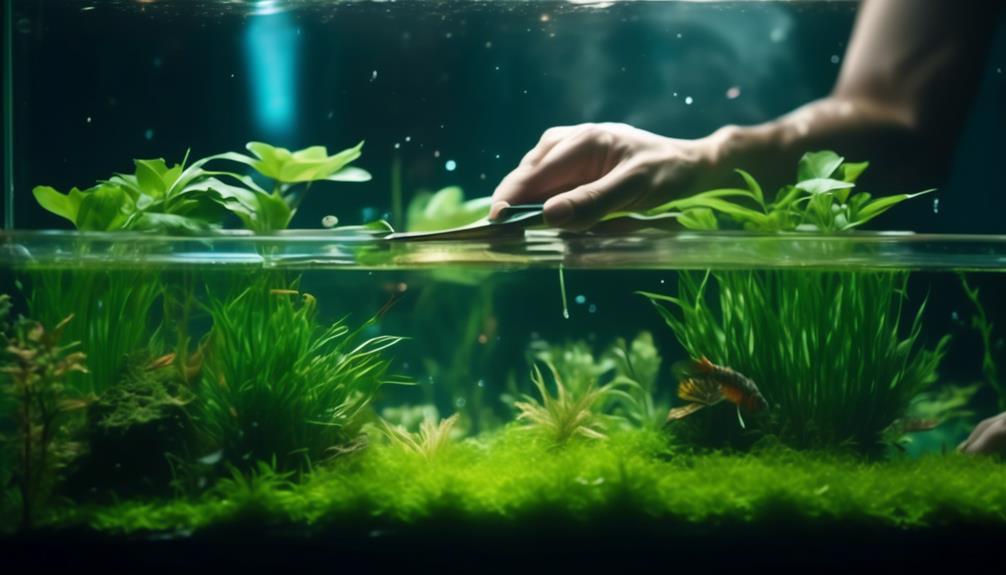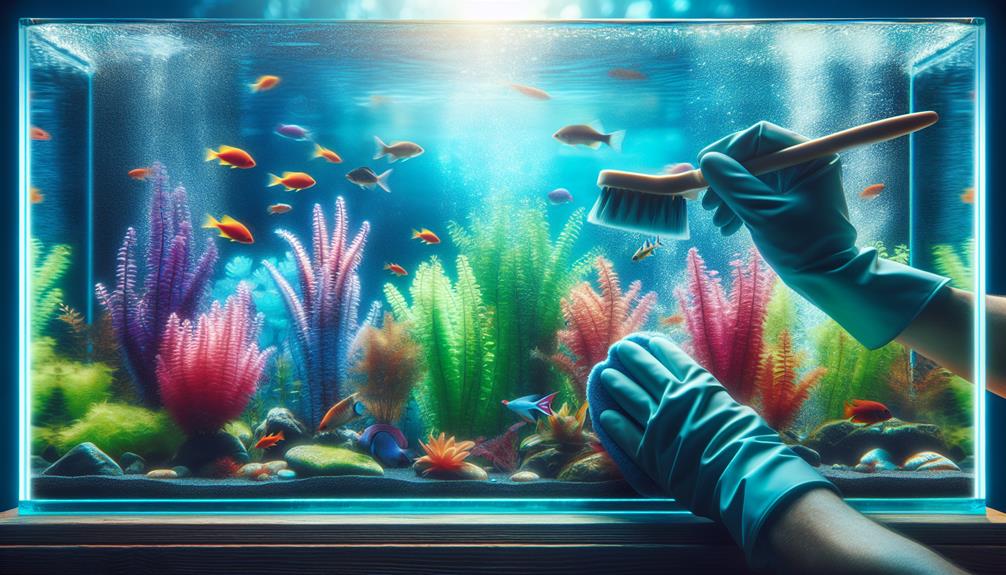Are you tired of your fish tank resembling a murky swamp instead of a sparkling oasis? It's time to give your aquatic haven the makeover it deserves.
In this discussion, we'll explore the secrets to reviving your fish tank with a series of pro cleaning tips. From ensuring the water quality is just right to tackling pesky algae and maintaining a healthy environment for your fish, we'll cover it all.
But that's not all – we'll also dive into the world of choosing the perfect fish and keeping them in top condition.
So, get ready to take the plunge into a world of aquatic rejuvenation.
Key Takeaways
- Regular fish tank cleaning is important for maintaining water quality and the overall health of your fish.
- It is not necessary to remove the fish from the tank when cleaning, but precautions should be taken to ensure their safety.
- After refilling the water, it is recommended to let it sit for a while before putting the fish back in to allow the temperature to stabilize.
- Essential cleaning supplies include ammonia test strips, algae scrubber, toothbrush, scissors, dechlorinator, glass cleaner, towel, and aquarium siphon.
Proper Water Testing
To ensure the health and well-being of your fish, proper water testing is essential. Water quality monitoring plays a crucial role in maintaining a thriving aquarium environment. By regularly testing the water parameters, you can identify any issues and take appropriate actions to rectify them.
The importance of water parameters can't be overstated, as they directly impact the overall health and longevity of your fish. Monitoring parameters such as pH levels, ammonia, nitrite, and nitrate levels is crucial in preventing harmful conditions that can lead to fish stress, disease, or even death.
Algae Removal Techniques
To effectively remove algae from your fish tank, follow these tried and tested techniques.
Algae control methods are essential for maintaining a clean and healthy aquarium environment. One effective technique is to manually remove the algae using an algae scrubber or a toothbrush. Gently scrub the affected areas, such as the glass, decor, or plants, to remove the algae buildup.
Another method is to introduce algae-eating fish or invertebrates into the tank, such as Amano shrimp or Siamese algae eaters, which can help control the algae population.
Additionally, preventing algae growth is crucial. Ensure proper lighting and avoid overfeeding your fish, as excess nutrients can contribute to algae growth. Regular water changes and proper filtration will also help maintain water quality and prevent algae blooms.
Pruning and Maintaining Plants

Pruning and maintaining plants in your fish tank is essential for ensuring their health and promoting a thriving aquatic environment. Properly cared for plants not only enhance the visual appeal of your tank, but they also provide oxygen, remove excess nutrients, and offer shelter for your fish. To help you effectively maintain your aquarium plants, here are some tips:
| How to Choose the Right Plants for Your Aquarium | Tips for Preventing Algae Growth in Planted Tanks |
|---|---|
| – Consider the lighting and nutrient requirements of the plants. | – Limit the amount of time your tank is exposed to direct sunlight. |
| – Choose plants that are suitable for your water parameters. | – Maintain proper water circulation and filtration. |
| – Opt for plants that are compatible with your fish species. | – Avoid overfeeding your fish to prevent excess nutrients in the water. |
| – Research the growth rate and size of the plants. | – Regularly trim and remove any dying or decaying plant material. |
Essential Equipment Cleaning
When it comes to maintaining a healthy and thriving aquarium, ensuring that your essential equipment is clean is crucial. Here are some tips to help you effectively clean your fish tank equipment:
- Toothbrush maintenance: Use a toothbrush to scrub away algae and debris from your filter, heater, and other equipment. Clean the toothbrush thoroughly after each use to prevent cross-contamination.
- Dechlorinator effectiveness: When cleaning your equipment, make sure to use a dechlorinator to remove harmful chemicals like chlorine from the water. This will ensure that your fish aren't exposed to any toxins when you refill the tank.
- Proper filter maintenance: Clean the filter regularly to remove accumulated debris and prevent clogging. Follow the manufacturer's instructions for disassembling, cleaning, and reassembling the filter components.
- Inspect and replace worn-out parts: Check your equipment regularly for any signs of wear or damage. Replace any worn-out parts to maintain the efficiency and effectiveness of your equipment.
Refilling and Finishing Touches

After completing the necessary equipment cleaning steps, it's time to move on to refilling your fish tank and adding those finishing touches. The key to a successful refill is maintaining the proper water temperature for your fish. Sudden temperature changes can stress or even harm your fish, so it's important to match the new water temperature to the tank water. Use a reliable thermometer to monitor the temperature and adjust accordingly.
In addition to temperature control, consider adding live plants to your aquarium. Live plants offer numerous benefits to both the fish and the overall ecosystem of the tank. They provide oxygen, absorb carbon dioxide, and help to filter out toxins. Live plants also create a natural and aesthetically pleasing environment for your fish. Some popular options include Java Fern, Anubias, and Amazon Sword.
To summarize, when refilling your fish tank, prioritize water temperature control and consider adding live plants for their many benefits.
Frequently Asked Questions
How Often Should I Clean My Fish Tank?
You should clean your fish tank regularly to maintain water quality. Use a gravel vacuum to remove debris and consider using an aquarium-safe scraper for the glass. Change the water based on your fish's needs and consult with experts for advice.
Can I Use Regular Household Cleaning Products to Clean My Fish Tank?
You should avoid using regular household cleaning products on your fish tank as they can be harmful to the fish. Instead, look for aquarium-safe alternatives specifically designed for cleaning fish tanks.
Is It Necessary to Remove the Fish From the Tank When Cleaning?
No, it is not necessary to remove the fish from the tank when cleaning. Cleaning without removing them reduces stress and the risk of injury. It also maintains the established ecosystem and helps the fish acclimate to the changes.
How Long Should I Let the Water Sit Before Adding the Fish Back In?
Let the water sit for at least 24 hours before adding the fish back in to ensure optimal water quality in your fish tank. This allows any chlorine or other chemicals to dissipate.
Are There Any Specific Safety Precautions I Should Take While Cleaning the Tank?
When cleaning your fish tank, it's important to take safety precautions. Wear gloves to protect your hands from chemicals, unplug electrical equipment to avoid accidents, and use proper cleaning equipment to prevent harm to your fish.
Conclusion
In conclusion, by following these pro cleaning tips, you can revive your fish tank and create a vibrant and healthy environment for your fish.
Did you know that according to a study conducted by the American Veterinary Medical Association, proper tank maintenance and regular water changes can significantly improve the lifespan and overall health of fish?
So, don't neglect your fish tank, give it the attention it deserves and enjoy the beauty of a thriving aquatic paradise.

